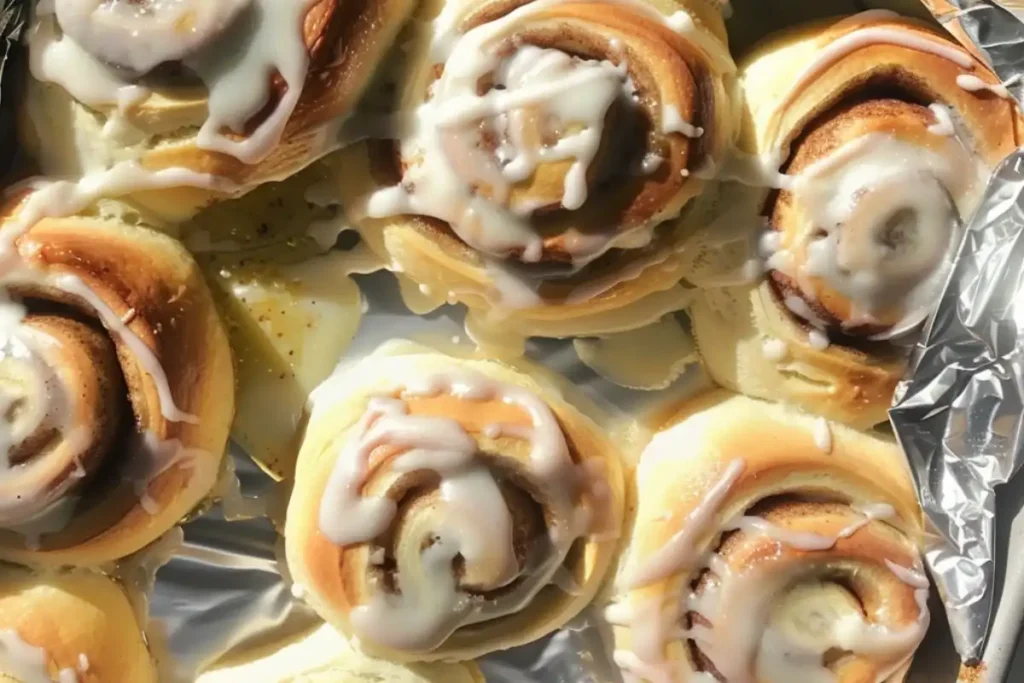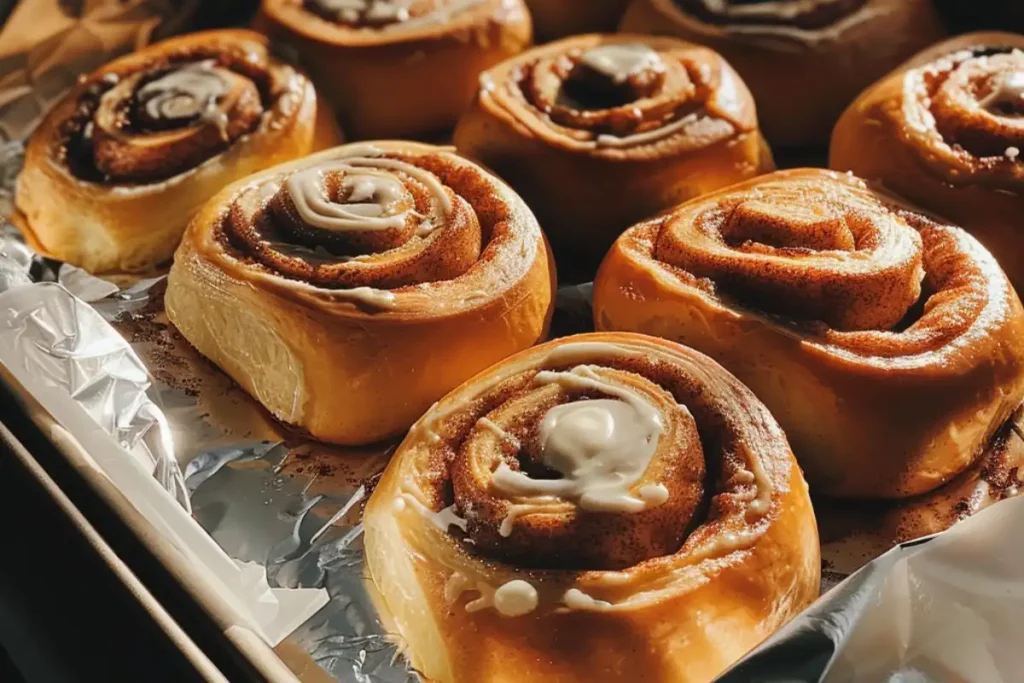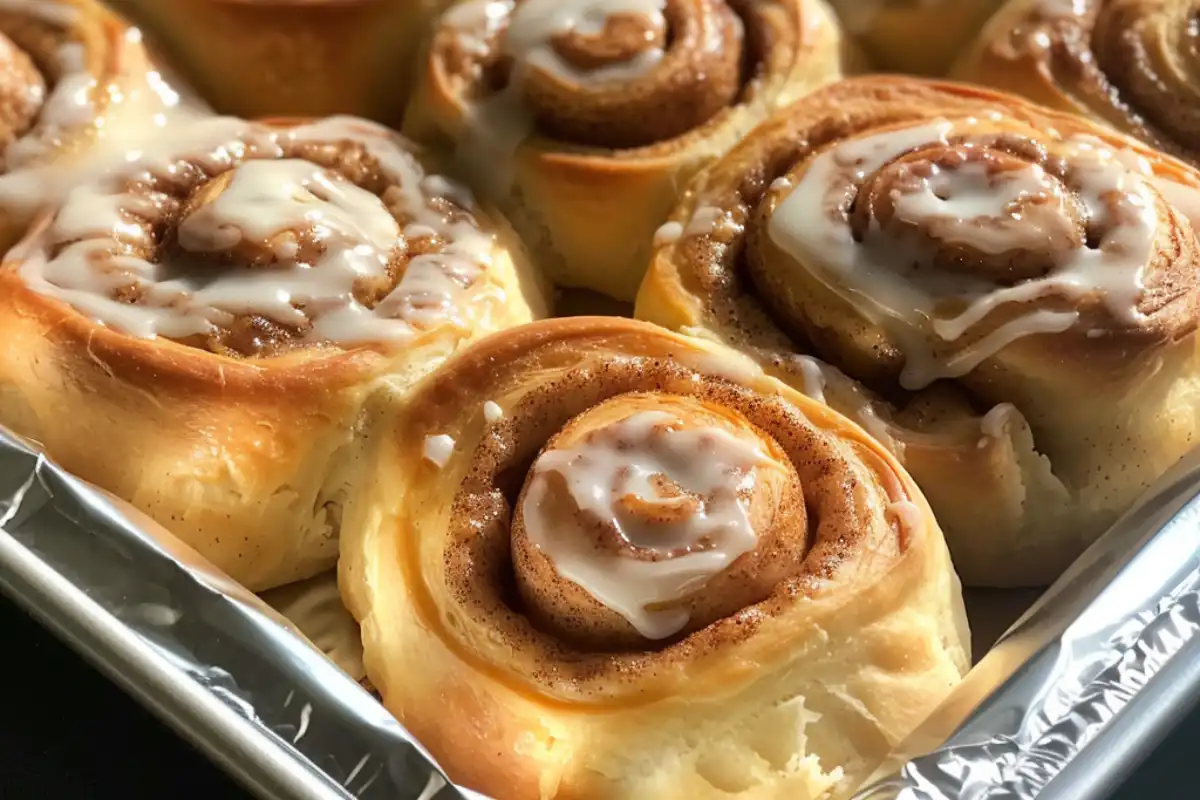Cinnamon rolls are a favorite treat for many, perfect for breakfast or a sweet dessert. However, one common question bakers often ask is, “Should you cover cinnamon rolls when baking?” The answer isn’t as straightforward as you might think. Covering or not covering cinnamon rolls affects the texture, moisture level, and browning of the rolls. Some bakers prefer covering the rolls to keep them soft and gooey. Others leave them uncovered to achieve that bakery-style golden-brown top.
Understanding the science behind baking cinnamon rolls is essential for getting the perfect texture. Whether you prefer them soft or with a slight crisp, you need the right method. For more tips on how to maintain moisture in your baked goods, check out The Secret to Moist Cupcakes.
Covering your cinnamon rolls can help prevent them from drying out, especially if your oven bakes unevenly. But, if you want to achieve that iconic caramelized crust, you may need to adjust your method. This guide will explore the pros and cons of covering cinnamon rolls while baking and provide step-by-step tips to get your desired texture. For more ideas on balancing moisture, see Why Do You Pour Milk Over Cinnamon Rolls? to learn how additional ingredients can improve your rolls.
Why Should You Cover Cinnamon Rolls When Baking?
Retaining Moisture for a Softer Roll
The main reason bakers choose to cover cinnamon rolls during baking is to keep them moist. Covering the rolls with aluminum foil or parchment paper creates a sort of mini-steaming effect. As the rolls bake, the moisture in the dough is trapped inside the baking dish, preventing the rolls from drying out. This method is especially helpful if you prefer your cinnamon rolls soft and gooey, with a melt-in-your-mouth center.
- How to Cover the Rolls Properly: Cover the cinnamon rolls loosely with foil during the first half of baking. Make sure not to wrap them too tightly, as this can cause the steam to condense too much, leading to soggy tops.
Baking cinnamon rolls covered for the first 15 minutes ensures that the dough has enough moisture to fully rise and develop a soft texture. Without covering, the surface may dry out before the center is fully baked. For those interested in soft, pillowy baked goods, see The Secret to Moist Cupcakes for more tips on retaining moisture during baking.
Preventing Over-Browning
Another reason to cover cinnamon rolls is to prevent over-browning. Since cinnamon rolls contain a lot of sugar, the tops can caramelize and darken quickly in the oven. Covering the rolls with foil acts as a barrier against the direct heat, allowing the rolls to bake through evenly without the tops browning too much.
This is especially useful for larger cinnamon rolls, which require longer baking times. By covering the rolls during the first part of the baking process, you protect them from becoming overly brown before the insides are fully cooked.
- Tip: If you’re worried about the tops browning too much, consider covering the rolls for the first 15-20 minutes, then removing the cover for the last 10-15 minutes to let them brown nicely.

For more on preventing over-browning and perfecting other baked goods, check out Should You Prebake Pumpkin Pie Crust?, which delves into prebaking techniques that can be applied to other recipes as well.
Why Not Cover Cinnamon Rolls When Baking?
Achieving a Golden-Brown Crust
Some bakers prefer not to cover cinnamon rolls because leaving them uncovered during baking creates a beautifully golden-brown crust. The sugar in the dough caramelizes when exposed to heat, making a slightly crispy top while the inside stays soft and fluffy.
- Tip: If you enjoy bakery-style cinnamon rolls with a golden, slightly crispy top, leave them uncovered. Alternatively, cover them during the first half of baking, then remove the cover for the last 10-15 minutes.
By leaving the rolls uncovered for most or all of the baking time, you allow the heat to hit the surface directly. This promotes caramelization and gives the rolls their characteristic color and texture. This method works well for those who like a balance between soft and crispy elements in their cinnamon rolls.If you’re aiming for that perfect golden-brown finish, learn more about the techniques from How to Achieve a Golden-Brown Crust to ensure your rolls come out just right.
Avoiding Sogginess
While covering the rolls during baking can help retain moisture, it can sometimes lead to soggy or overly moist rolls if left covered for too long. The steam generated inside the baking dish can condense on the foil and drip back onto the rolls, leaving the tops too wet and preventing them from achieving the desired crispness.
- Solution: To avoid sogginess, uncover the rolls during the last 10 minutes of baking to allow the tops to dry out and become golden.
Uncovering the rolls towards the end of baking provides the best of both worlds: soft, moist interiors with golden-brown, slightly firm tops.
When Should You Cover Cinnamon Rolls?
During the First Half of Baking
A popular method among bakers is to cover the cinnamon rolls for the first half of the baking process and then uncover them for the final 10-15 minutes. This technique allows the dough to steam and stay moist in the beginning while giving the rolls a golden, crispy top toward the end.
- Tip: Monitor the rolls closely as they bake, and if you see the tops browning too quickly, cover them loosely with foil. This will help prevent burning while still allowing them to bake through properly.
This method works particularly well for large rolls or rolls that have been proofed in a cooler environment, as they may need more time in the oven to fully bake.
When Baking Large Cinnamon Rolls
If you’re baking extra-large or oversized cinnamon rolls, covering them for the first half of the baking time is crucial. Large rolls take longer to cook all the way through, and covering them ensures the tops won’t brown too quickly while the inside is still raw.
- Pro Tip: When baking large cinnamon rolls, keep the cover on for the first 20 minutes, then uncover them for the final 10 minutes for that perfect golden-brown finish.
By adjusting the cover timing, you can ensure that the rolls are evenly baked without burning the tops or leaving the centers undercooked.
Step-by-Step Guide to Baking Cinnamon Rolls
Step 1: Prepare the Dough
Perfect cinnamon rolls start with the dough. Using a soft, enriched dough made with butter, milk, and sugar gives the rolls their tender and fluffy texture. Knead the dough just enough to bring it together without overworking it, as this can make the rolls dense.
- Tip: A combination of all-purpose and bread flour can help balance the structure and softness of the dough.
Once the dough has been kneaded and allowed to rise, it’s time to roll it out and add the cinnamon-sugar filling.
Step 2: Roll and Fill the Dough
After the first rise, roll out the dough into a large rectangle. Spread softened butter over the surface and generously sprinkle with the cinnamon-sugar mixture. Roll the dough tightly and slice it into even portions.
- Tip: Use dental floss to slice the dough cleanly without squashing it. Slide the floss under the roll, cross the ends over the top, and pull to create perfect slices.
Step 3: Second Rise
Once the cinnamon rolls are placed in a baking dish, allow them to rise again for a second time. During this rise, cover the rolls with a damp cloth or plastic wrap to keep the dough from drying out.
- Tip: Place the rolls in a warm, draft-free location for the second rise to ensure they expand fully and develop their soft texture.
Step 4: Baking the Rolls
Preheat the oven to 350°F and bake the cinnamon rolls for 25-35 minutes, depending on their size. If you choose to cover the rolls, do so for the first 10-15 minutes to allow the dough to steam and stay moist.
- Tip: If you prefer a bakery-style golden top, remove the cover during the last 10 minutes of baking to let the tops caramelize.
Step 5: Frosting the Rolls
Once the rolls are baked, let them cool slightly before adding your frosting. Whether you prefer a classic cream cheese frosting or a powdered sugar glaze, spreading the frosting while the rolls are still warm allows it to melt into the crevices.

- Tip: Apply the frosting while the rolls are warm, but not hot, to prevent the frosting from melting too much and running off the sides.
FAQs About Covering Cinnamon Rolls
1. Should cinnamon rolls be baked covered or uncovered?
- Both methods have their advantages. Covering the rolls for part of the baking process helps them stay soft and moist, while uncovering them for the last few minutes gives the tops a golden-brown finish.
2. What happens if you don’t cover cinnamon rolls when baking?
- If you don’t cover cinnamon rolls, the tops may brown too quickly, which can result in a dry, hard crust. However, leaving them uncovered for part of the baking process can produce a nice golden, slightly crispy finish.
3. Can I bake cinnamon rolls in advance?
- Yes, you can bake cinnamon rolls in advance and store them in an airtight container. To reheat, simply warm them in the oven or microwave before serving. For more tips, check out How to Store Cinnamon Rolls to keep them fresh.
4. Why are my cinnamon rolls dry after baking?
- Dry cinnamon rolls are often caused by over-baking or not covering them during the first part of the baking process. Covering the rolls helps retain moisture, preventing them from drying out.
5. How long do cinnamon rolls take to bake?
- Cinnamon rolls typically take 25-35 minutes to bake, depending on their size and oven temperature. To check for doneness, use a thermometer to ensure the center of the rolls reaches 190°F.
Conclusion
To cover or not to cover? That’s the question when it comes to baking cinnamon rolls. If you prefer soft, moist rolls, try covering them during the first half of baking. This helps retain moisture and prevents over-browning. However, if you enjoy a golden-brown, slightly crispy top, leave them uncovered. Alternatively, you can uncover them in the last few minutes of baking.
Experimenting with different methods will help you find the best approach for your taste. Try both techniques and see which one results in the perfect cinnamon roll for you!
For more baking tips and tricks, don’t forget to check out Why Do You Pour Milk Over Cinnamon Rolls? to learn more about how small adjustments can transform your cinnamon rolls.

